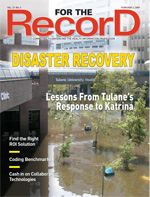Coding for Osteoporosis
For The Record
Vol. 21 No. 3 P. 28
Osteoporosis cases fall into two categories: primary and secondary. There are three types of primary osteoporosis:
• Postmenopausal osteoporosis (ICD-9-CM code 733.01) is caused by a lack of estrogen and affects women between the ages of 51 and 75.
• Senile osteoporosis (733.01) results from age-related calcium deficiency, occurring in people older than the age of 70. It’s twice as common in women, who can have senile and postmenopausal osteoporosis simultaneously.
• Idiopathic osteoporosis (733.02) occurs in children and young adults with normal hormone levels and function, normal vitamin levels, and no obvious reason for weak bones. The cause is unknown.
Secondary osteoporosis is usually caused by medical conditions (eg, chronic renal failure, rheumatoid arthritis) or hormonal disorders (eg, hyperthyroidism). Other causes include the following:
• Disuse osteoporosis (733.03) is due to bone immobilization or disuse (eg, hemiplegia).
• Drug-induced osteoporosis (733.09) can be caused by corticosteroids, heparin, barbiturates, and anticonvulsants. If a drug was taken correctly (adverse effect), sequence code 733.09 first, followed by the therapeutic use E code identifying the drug. If a drug was taken incorrectly, sequence the poisoning code first, followed by code 733.09 and the E code identifying the poisoning circumstances. When the documentation does not state whether the drug was taken correctly or incorrectly, it is assumed that the drug was taken correctly (adverse effect).
If the documentation mentions curvature of the spine associated with osteoporosis, assign one of the following codes in addition to the osteoporosis code, sequencing the osteoporosis code first:
• Kyphosis (737.41) — increased convexity of the thoracic spine;
• Lordosis (737.42) — increased concavity of the lumbar spine;
• Scoliosis (737.43) — lateral curvature of the spine; or
• Unspecified curvature of the spine (737.40).
Other codes for osteoporosis include osteoporosis circumscripta (731.0); posttraumatic osteoporosis (733.7), which also includes disuse atrophy of bone; and wedging of vertebra NOS (733.00).
Pathological Fractures
Osteoporosis has no symptoms until a fracture occurs, which causes bone pain, height loss, and abnormal spine curvature. If a fracture is determined to be due to osteoporosis, it is considered a pathological fracture, which is a break of a diseased or weakened bone without any identifiable trauma or following a minor injury that would not ordinarily break a healthy bone. A pathological fracture is classified to code 733.1x, with a fifth digit identifying the fracture site. Osteoporotic fractures often occur in the vertebra (733.13), hip (733.14), or wrist (distal radius or Colles’ fracture, 733.12).
However, because a patient has a bone-weakening condition does not mean a fracture is pathologic. Only the physician can determine whether the fracture is traumatic or pathologic, and physician documentation must be obtained to clarify.
The following terms are synonymous with pathological fracture: spontaneous fracture, insufficiency fracture, nontraumatic fracture, and nontraumatic compression fracture. When one of these terms is documented, a code from subcategory 733.1 may be assigned instead of a code from 800 to 820. If the physician documents stress fracture, assign one of the following codes:
• 733.93, Stress fracture of tibia or fibula;
• 733.94, Stress fracture of the metatarsals;
• 733.95, Stress fracture of other bone;
• 733.96, Stress fracture of femoral neck;
• 733.97, Stress fracture of shaft of femur; or
• 733.98, Stress fracture of pelvis.
The sequencing of osteoporosis and pathological fracture depends on the circumstances of admission. If a patient is admitted to treat the pathological fracture rather than osteoporosis, the fracture should be sequenced first, followed by the code for osteoporosis.
Compression Fracture
Compression fractures may be considered traumatic (work or sports related) or pathologic (due to disease process). Review the medical record to determine whether there was significant trauma to cause the compression fracture. If the documentation is unclear, ask the physician for clarification. Never assign a code for a traumatic fracture with a code for a pathologic fracture at the same site.
Coding and sequencing for osteoporosis are dependent on the physician documentation in the medical record and application of the Official Coding Guidelines for inpatient care. Also, use specific AHA Coding Clinic for ICD-9-CM and American Medical Association CPT Assistant references to ensure complete and accurate coding.
— This information was prepared by Audrey Howard, RHIA, of 3M Consulting Services. 3M Consulting Services is a business of 3M Health Information Systems, a supplier of coding and classification systems to more than 4,000 healthcare providers. The company and its representatives do not assume any responsibility for reimbursement decisions or claims denials made by providers or payers as the result of the misuse of this coding information. More information about 3M Health Information Systems is available at www.3mhis.com or by calling 800-367-2447.




